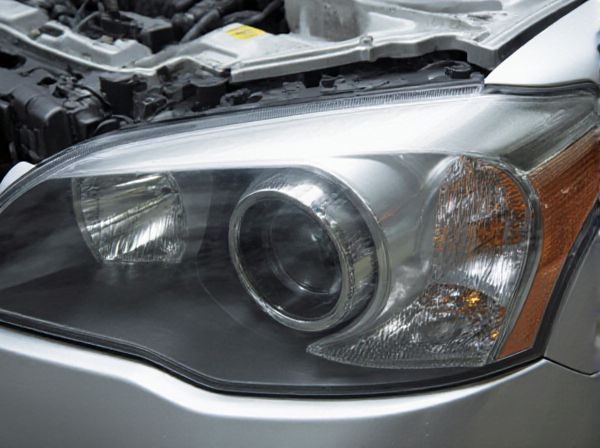
Photo illustration: Sealed Beam Headlight vs Composite Headlight
Sealed beam headlights consist of a single, enclosed unit where the filament, reflector, and lens are integrated, offering durability but limited flexibility in design and brightness. Composite headlights feature replaceable bulbs within a separate housing, allowing for customization, improved light output, and easier maintenance. Your choice between the two impacts vehicle aesthetics, performance, and repair costs.
Table of Comparison
| Feature | Sealed Beam Headlight | Composite Headlight |
|---|---|---|
| Design | All-in-one sealed unit | Replaceable bulb with separate housing |
| Light Output | Lower brightness, limited beam pattern | Higher brightness, precise beam control |
| Maintenance | Full unit replacement needed | Bulb replacement only |
| Durability | Robust, less prone to moisture | More vulnerable to damage and moisture |
| Cost | Cheaper upfront | Higher initial cost, cost-effective long term |
| Application | Older vehicles, classic cars | Modern vehicles, advanced lighting systems |
Introduction to Automotive Headlights
Automotive headlights are essential for vehicle safety, providing visibility in low-light conditions and signaling intentions to other drivers. Sealed beam headlights feature a single, integrated unit with the filament, reflector, and lens sealed together, offering durability but limited design flexibility. Composite headlights allow separate replacement of bulbs, lenses, and reflectors, enabling advanced shapes and better light performance with modern halogen, HID, or LED technology.
What Are Sealed Beam Headlights?
Sealed beam headlights are automotive lighting units where the filament, reflector, and lens are permanently integrated into a single, replaceable assembly. These headlights are typically round or rectangular and were widely used in vehicles before the introduction of composite headlights. Their all-in-one design offers durability and simple replacement but limits customization and light output efficiency compared to modern composite headlights.
What Are Composite Headlights?
Composite headlights consist of a housing, reflector, and replaceable bulbs, offering greater design flexibility and improved lighting performance compared to sealed beam headlights. These headlights accommodate halogen, HID, or LED bulbs, allowing easy bulb replacement without changing the entire unit. Advances in lens materials and reflector technology enhance light output and beam precision in composite headlight systems.
Key Differences Between Sealed Beam and Composite Headlights
Sealed beam headlights consist of a fixed, integrated unit where the filament, reflector, and lens form a single sealed component, providing durability but limited customization. Composite headlights feature separate bulbs and housings, allowing easier bulb replacement and design flexibility for improved aerodynamics and lighting performance. The key differences lie in maintenance convenience, design adaptability, and overall lighting efficiency, with composite headlights offering more modern advancements compared to the traditional sealed beam units.
Performance and Brightness Comparison
Sealed beam headlights provide consistent light output with a fixed reflector and bulb design, ensuring durability but limited brightness customization. Composite headlights offer superior performance by allowing separate bulb replacements and advanced reflector or projector lenses, resulting in higher brightness and improved beam focus. Brightness in composite headlights typically surpasses sealed beams, enhancing visibility and safety during night driving.
Durability and Lifespan
Sealed beam headlights feature a one-piece construction with the bulb, reflector, and lens sealed together, resulting in high durability and resistance to moisture and dust, which extends their lifespan significantly. Composite headlights consist of separate replaceable components, allowing for easier maintenance but potentially reducing overall durability due to the use of plastic lenses that can degrade from UV exposure. Sealed beam headlights typically last around 3,000 to 5,000 hours, while composite headlight bulbs can last similarly, but their plastic housings often require replacement every 5 to 10 years due to wear and damage.
Installation and Replacement Process
Sealed beam headlights feature an all-in-one design, making installation straightforward by simply replacing the entire unit, which is ideal for quick fixes but limits customization options. Composite headlights separate the bulb from the housing, allowing for easier bulb replacement without changing the entire assembly and offering flexibility for upgrades like halogen or LED bulbs. The installation process for composite headlights is more complex, often requiring more tools and time, but provides long-term cost savings and improved performance adaptability.
Cost Analysis: Sealed Beam vs Composite
Sealed beam headlights typically cost less upfront, averaging around $15 to $50 per unit, making them a budget-friendly choice for basic vehicle lighting. Composite headlights, while more expensive with prices ranging from $100 to $600, offer long-term value due to replaceable bulbs and better energy efficiency, reducing maintenance expenses. Evaluating total cost of ownership reveals sealed beams incur higher replacement frequency and labor costs, whereas composite headlights provide economic benefits through durability and improved performance.
Customization and Styling Options
Composite headlights offer extensive customization and styling options due to their separate, replaceable components like bulbs and lenses, allowing for variations in color, shape, and lighting technology such as LEDs or HIDs. Sealed beam headlights are limited in customization because the entire unit is a single, sealed component, restricting choices to standard shapes and sizes. Enthusiasts favor composite headlights for their flexibility in upgrading aesthetics and performance, making them ideal for personalized vehicle styling.
Which Headlight Is Best for Your Vehicle?
Sealed beam headlights offer a durable, all-in-one design ideal for classic cars and trucks needing straightforward replacement units, while composite headlights provide superior light output and design flexibility favored in modern vehicles. For optimal visibility and aesthetic customization, composite headlights with replaceable bulbs and advanced reflector or projector technology are the best choice. Consider your vehicle's compatibility, maintenance preferences, and lighting performance requirements when choosing between sealed beam and composite headlights.
 caratoz.com
caratoz.com